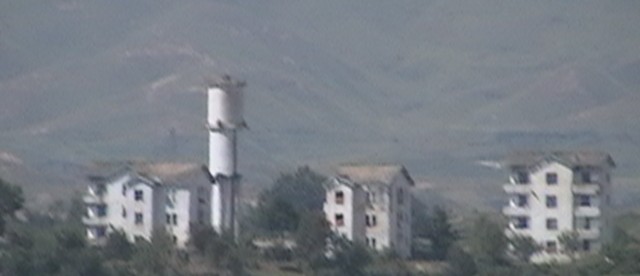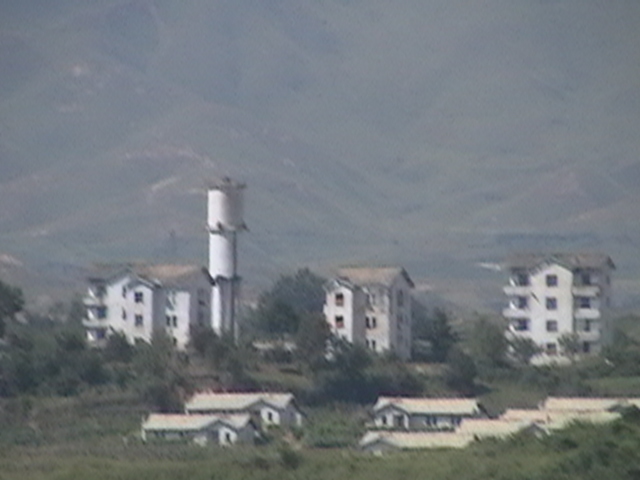Kijong-dong

In 1953, North and South Korea entered into an armistice which ended the Korean War and provided a shaky basis for something close to peace between the two nations. Part of the terms of the armistice provides for a four kilometer-wide demilitarized zone (DMZ) running between the two nations, and each nation had to abandon all but one settlement within the DMZ, keeping or creating a sole outpost of their choosing. South Korea opted for Daeseong-dong, a small farming town whose name translates to “Freedom Village” and is home to about 225 residents.
North Korea, on the other hand, decided to build something new — something they call Kijong-dong, or the “Peace Village,” pictured above. Kijong-dong, per Wikipedia, “features a number of brightly painted, poured-concrete multi-story buildings and apartments, many [unlike the rest of North Korea] apparently wired for electricity.” It is a city of luxury (by North Korean standards, at least). And it is a monument to, well, peace. No one who lives there has ever touched a weapon, fought in a war, or otherwise harmed another person.
That’s because no one lives there at all.
Kijong-dong is a ghost town — one which, unlike most ghost towns, never had anyone living there. It’s a pure propaganda play: by building a high-end town near the South Korean border, the North Korean government can put its best foot forward. And as no one is going to visit anyway, there’s really no reason to allow anyone to live there to muck things up. It’s all a big ruse. In the summer of 2014, for example, the New York Post reported that “buildings [in Kijong-dong] are actually concrete shells with no glass in their windows.” Slate notes that “electric lights—an unheard of luxury for rural North Koreans—operate on an automatic timer” and “the only people in sight are maintenance workers, occasionally dispatched to sweep the streets in order to give the impression of ongoing activity.” Reports from various plays all say the same thing: Kijong-dong’s population is a very stable “zero.”
Officially, North Korea denies these facts. The communist nation famous for its borderline delusional adhesion to false truth claims that Kijong-dong is, per the book “Unruly Places: Lost Spaces, Secret Cities, and Other Inscrutable Geographies” (excerpted by Boing Boing here), a “thriving community.” The village is home to about 200 families, “contains a large collective farm,” and offers “many social services, such as schools and a hospital.” And then, there’s the flag.
That’s a wider angled view of Kijong-dong, and you’ll note a very tall tower near the center of the image. That’s a flagpole. In the 1980s, South Korea constructed a 323 foot tall flagpole in Daeseong-dong, and, not to be outdone, North Korea got to work on its own tower. It is 525 feet tall — the second largest in the world at the time it was built — and dons a North Korean flag weighing over 500 pounds. Like the rest of the town, the flagpole is designed to be an advertisement for the greatness that is North Korea.
But of course, it’s more a punchline than an invitation. While North Korea wanted Kijong-dong to be a monument attesting to the nation’s peace and prosperity, the rest of the world has given it a different name; it is often referred to as “Propaganda Village.”
Bonus Fact: The world’s tallest flagpole is the Jeddah Flagpole in Saudi Arabia — it’s 558 feet high. According to Wikipedia (and there’s a picture at that link), the flagpole is home to a flag which weighs 570 kg (about 1,250 pounds).
From the Archives: A Tree Falls in North Korea: The joint U.S./South Korea operation to cut down a tree in the DMZ.
Take the Quiz: North Korea ranks countries based on a propriety “Happiness Index.” Name the top five countries (and two others) according to their metrics.
Related: A $12,000 flagpole. It’s only 40 feet high, which makes the Jeddah Flagpole insanely expensive.


